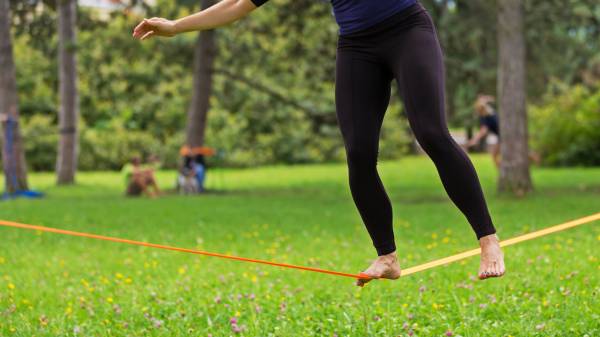In performance terms, running is a pursuit. It’s a distance, for time. In mindset terms, running is a chance to be free from any situation. In system input terms, running is an opportunity to create positive or negative change.
In performance terms, running is a pursuit. It’s a distance, for time. In mindset terms, running is a chance to be free from any situation. In system input terms, running is an opportunity to create positive or negative change.
These are true of all running. But if you also want to improve adaptability of your feet and lower limbs to improve both your running and other tasks, then introducing an environment that forces you to be aware of where your foot is going to land is beneficial. If you desire for adaptability of movement control from your feet up, trail running is for you.
Trail running forces you to be aware of where your foot is going to land.
Do You Trust Your Feet?
Your first consideration is whether you trust your feet. Think of Kayla Montgomery, an award winning cross country athlete with multiple sclerosis. As her body heats up, she loses sensation from the waist down. Not being able to feel her feet means an enormous amount of trust that her primitive reflexes are working for her with each step. That’s a stupendous amount of trust. Running on a trail, with tree roots, potholes, and undulations in any combination of directions requires an acceptance of weight to accommodate the shift in surface. That requires reflexive adaptation and some pre-planning of foot placement. It’s particularly neurologically stimulating.
The intensity that occurs with trail running is typically nowhere near track or pavement running by necessity. You have to dial it back to avoid tripping over. When you run on a pavement, you trust that the surface is consistent, so the automatic pattern of running is set in motion and you can put your foot down, literally. You can trust that you don’t need to adapt, so the purpose of each step is to reuse the elasticity of your tendons to quickly spring off the surface.
Why Slack-Lining Isn’t the Answer
But wait a minute. I hear my slack-lining friends asking, “Well if it’s foot adaptability you want, look no further than the slack-line!” Well, my friends, here’s why slack-lining is not a good exercise for runners.
Slack-lining is great for slowly-applied load to the feet where dynamic control of the subtalar joint and midfoot joints is required. Having a supple foot helps keep you on the line. But that’s not beneficial for running. In running on pavement, having a supple and adaptable foot is wasted energy – we need the midfoot NOT to be supple, but stiff. Not to keep you on the surface, but to bounce off quickly.
In running on a trail, we need a bit of both. The midfoot still needs to be stiff enough to bounce us off the ground, but supple enough to adapt to the surface. That mix of demands makes it very neurologically demanding, and great for increasing your foot adaptability.
Activation for Adaptability
To obtain the foot adaptability a runner dreams of, we have to trail run – and we have to ensure the foot has enhanced mobility of the small middle joints. Like any fitness endeavor, failing to prepare is to prepare to fail. The old trick of rubbing the sole of the foot across a golf ball is a very good one. To massage the feet is to enhance the sensitivity of them and to ripen the nervous system to reflexively react to the forces applied to it. This acts as a reset of the foot, and we used it successfully in the Chinese women’s volleyball team in preparation for our victorious FIVB World Cup.
Then comes activation. As Perry Nickelston says, we should follow a reset with activation before integrating it into more complex tasks. Activation can be as simple as scrunching and spreading the toes. It could also be walking on the ball of the feet, or on the heels for a short distance. It could be incorporated into split kneeling tasks like a halo, a curl to press, or a Turkish get up.
The final integration is as simple as double leg bounces transitioning to skipping before you head out onto the trail. Then locomotion. The quick foot rub with a golf ball, field hockey ball, cricket ball or even a tennis ball should be a key part of your pre-trail run routine.

Slack-lining is great for slowly-applied load to the feet – but it won’t help your running.
Appropriate activation enables you to pay better attention to the terrain, and this is complimented by having a sensitive interface with the earth with your shoe. I’m guided in this by the excellent podiatrist Tim Bransdon of The Running Lab. On his recommendation, Vivobarefoot shoes fits the four rules of simple footwear – light, flat, flexible and shaped like a foot, but these shoes protect the sole of the foot from sharp objects. Like all minimalist shoes, however, if they are a change from your usual shoes with a positive heel (where the heel section is thicker than the forefoot section), you have to dial back on volume (distance and time) and intensity (speed).
Trust In the Trail
Trail running is an invaluable inclusion to track or road running programs. The adaptability required on less trustworthy surfaces is neurologically challenging, which is great for learning. The physiological demand is lower than pavement or track, and there’s an opportunity to switch up your regular conditions and just get out there. Hit the trail to discover the great adaptability benefits running can provide.
More Like This:
- Fix Your Hill Running Technique for Faster, Smoother Runs
- The Pros and Cons of Barefoot Running: What the Research Says
- 2 Critical Exercises to Prepare Your Feet for Minimalist Footwear
- New on Pulse Beat Fit Today
Photos courtesy of Shutterstock.






